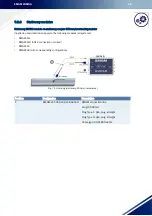
SMGM SYSTEM
63
8
SMGM SYSTEM
8.1
General system description - SMGM
Fig. 8-1 SMGM system concept
The SMGM communication system provides a mobile communication interface, forcibly guided at the SMGM
rail, for the transmission of standard Ethernet protocols. A communication link between the stationary seg-
ment interface (SMGM-SI) and the mobile device interfaces (SMGM-DI or BCC/SMGM) is provided. The trans-
mission corresponds to the communication path 1 in the illustration SMGM system concept.
However, based on the system features, latency times occur during the communication. A transmission band-
width will be made available in the SMGM cycle for each mobile device (see section “8.3 Bandwidth schemes
- SMGM”). This means that an individual participant never has the full bandwidth available.
During a segment change, the communication with the mobile participant will be transferred from one SMGM-
SI module to the next one. Therefore, the Ethernet communication paths (switching tables) must be re-as-
signed in the cable based network. To keep the latency period as short as possible, the SMGM-SI modules
should not be connected underneath other PROFINET devices. The SMGM modules should wherever possible
always be connected on the highest switch level. Otherwise, the latency periods must be included in the timing
calculation for the networks.
TIPS AND RECOMMENDATIONS!
Information on the SMGM system
Due to the system-induced latency periods when changing segments, to reduce the
network load and to avoid problems with data transmission it is recommended to op-
erate the stationary SMGM components in separate Ethernet networks.
















































